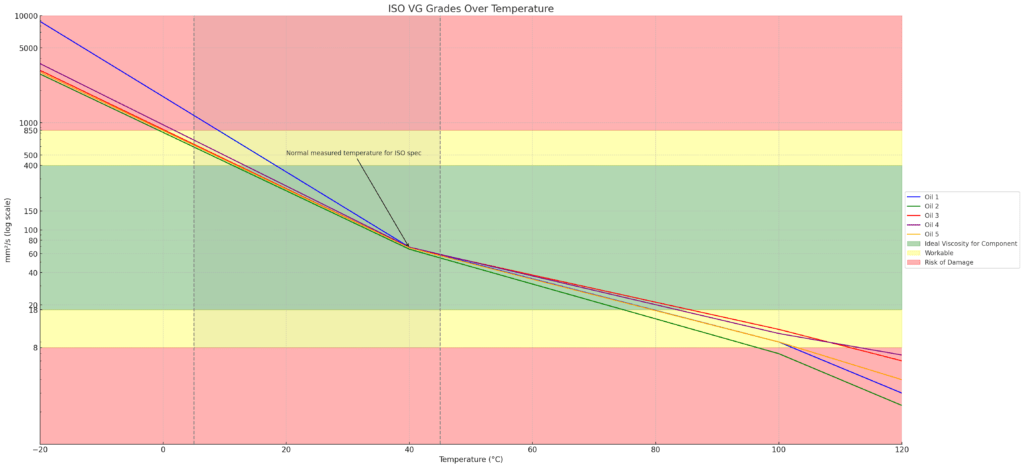Viscosity is the most important property of an oil. It’s a well established fact. If you want to prevent wear the viscosity MUST be right. I have covered articles on this site on viscosity grading systems including ISO and SAE measuring viscosity at 40 and 100C respectively. However, it’s operating temperature that counts. In fact that might not be one temperature but a range of temperatures and can vary quite wildly depending on environmental factors.
Despite the critical role of viscosity in lubrication, many lubricants are still marketed and selected based on their viscosity at standard temperatures like 40°C or 100°C, which can be misleading. This is particularly true for components like hydraulics, bearings, and fridge compressors, where the actual operating temperature range can vary significantly.
In the realm of cold temperatures, terms like pour point and cloud point come into play. However, by the time these points are reached, the oil’s viscosity may already be too thick to provide effective lubrication. This highlights the crucial need to focus on the oil’s performance across its entire operating temperature range.

Kappa of bearings
The concept of Kappa number plays a vital role here. It represents the ratio of operating viscosity to minimum required viscosity. A Kappa number around 1 indicates boundary lubrication, necessitating high levels of Extreme Pressure (EP) additives. A number close to 1 falls under mixed film lubrication, often requiring some antiwear additives. A Kappa number around 4 suggests a good full film lubrication, which is ideal. Maintaining this ‘Goldilocks zone’ of 2 to 4 across the operating range is essential for efficient lubrication. However, it’s important to note that a higher Kappa number can lead to poorer energy efficiency and more effort to move components. Hence, finding the right balance is key.
When we consider different machinery types, the operating range for viscosity can vary widely. Typical hydraulic systems may operate most effectively with viscosities ranging from 16 to 50 mm²/s, but they can allow for a broader range of 15 to 800 mm²/s. Some compressors may peak around 500 mm²/s, while certain pumps and bearings can go up to 1500 or even 2000 mm²/s.
Calculating the minimum viscosity (Vmin) in bearings is another critical aspect. For bearings operating under 1000 RPM, the formula is Vmin = 45,000 * n^0.83 * a^0.5. For those operating above 1000 RPM, it becomes Vmin = 4,500 * n^0.5 * d_m^-0.5.
Viscosity at YOUR temperatures
Traditionally, viscosity is measured at set temperatures like 40 or 100°C, which is useful for condition monitoring. However, for selecting the right lubricant or evaluating a new oil, considering the entire operating temperature range, as well as minimum and maximum viscosities within this range, is more practical.
At Oil Analysis Laboratories, we recognize the importance of measuring operating viscosity across a wide range of temperatures. Our capability to measure viscosity from 0.2 to 30,000 mm²/s across temperatures from -40 to +130°C allows us to offer our customers comprehensive assessments for lubricant selection in tenders or when comparing suppliers, all done independently.
Now this is realistically not something that you would have on every sample as test times can be up to an hour a sample for this type of research, compared to a couple of minutes at single temperatures. However, since our business is all about helping customers reducing failures of machinery and viscosity is the most important property of an oil it seems stupid when potentially spending 5 or 6 figures on lubricating oil to not review this data.
Now in engine oils there is a lot of test bed testing that goes into the oil specifications so there are already numerous viscosity measurements at varying temperatures as well as field engine tests and approvals. These narrow down the lubricant choices for many engines to a handful of formulations. However, in industrial lubricants this is less so and there can be hundreds if not thousands of oils all with varying formulations that could be considered suitable based on a simple ISO viscosity number. When I first started offering this test the easiest sell in this area was compressors as they have such wide temperature ranges. However even simple ambient hydraulics with not huge extremes still can benefit.
A case study from a hydroelectric system highlights this point. The system experienced a wide ambient temperature range from -7 to +32°C over three months. The initial oil used had a Kappa range of 164 to 3, leading to repeated issues. Our analysis helped them test alternative oils, and the new selection from their current supplier offered a significantly improved Kappa range of 21 to 3.4, enhancing energy efficiency and saving the customer £31,000 annually on just a small number of systems.
An example of how measuring viscosity at operating temperature range can aid you in making maintenance decisions.
This case study underscores the importance of considering the full spectrum of operating temperatures and not just relying on standard temperature viscosity measurements or extrapolations from the viscosity index. Accurate, real-world measurements provide invaluable insights for optimal lubricant selection, directly impacting efficiency and longevity of the machinery.
What it means for you?
On the whole, you are still going to measure at standard temperatures for condition monitoring as heating and cooling down viscometers to accommodate a wide range of operating temperatures for thousands of samples a day at a commercial lab is too impractical. So measuring at the set 40 and 100 degrees Celsius temperatures makes sense for day to day routine analysis. However if you are looking to select a new lubricant you want as much information as possible. Equally when formulating a lubricant for specific applications then the ability to measure viscosity at a wide temperature range is exceptionally useful.
If you are interested in looking how a specific oil will cope at different temperature ranges then reach out and click contact us for additional information.
